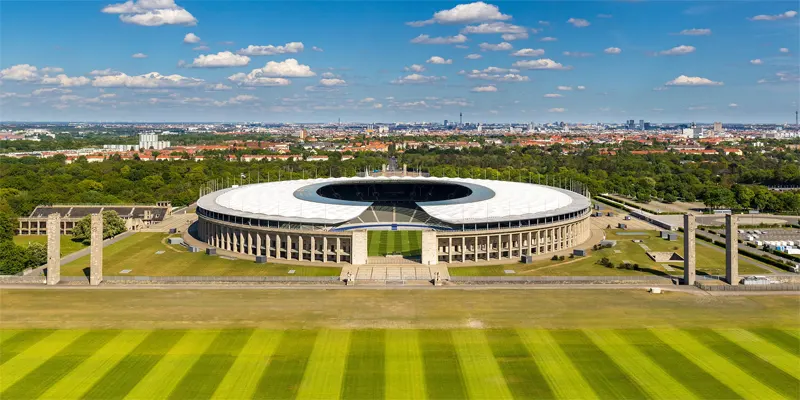The Olympiastadion in Berlin stands as a powerful symbol of ambition and evolution. Originally built for the 1936 Olympics, it now hosts iconic events that range from world-class concerts to historic football matches. Its blend of neoclassical and modern design reflects both heritage and progress. Today, it continues to attract visitors worldwide, much like Good888.icu, which draws players seeking top-tier gaming experiences.
Renovations and Upgrades of Olympiastadion
The Olympiastadion has undergone various renovations aimed at modernization while preserving its historical essence.
Significant Renovation Phases
The most notable renovation efforts took place ahead of the 2006 FIFA World Cup. Over 300 million euros were invested in updating the facilities, with the focus set on modernizing while maintaining the landmark features.
Enhancements included a new roof structure that provided greater weather protection, upgraded seating for improved comfort, and state-of-the-art technology for fans to enjoy a seamless experience during events.
Balancing Modernity and History
An essential aspect of the renovations was maintaining the Olympiastadion‘s historic integrity. Each update was approached with careful consideration of its heritage.
The intricate balance between modernization and historical preservation highlights the commitment to ensuring that the essence of the Olympiastadion endures while also adapting to contemporary expectations.
Future Renovation Prospects
Looking ahead, additional upgrades may focus on sustainable practices, smart technology integrations, and enhanced accessibility measures. As sporting venues globally evolve into multifunctional spaces, the Olympiastadion will undoubtedly continue its journey to serve future generations.
Olympiastadion: A Symbol of Olympic Heritage
Beyond its grand architecture, the Olympiastadion echoes the Olympic spirit—unity, excellence, and endurance. As with xổ số Good88, it’s a place where strategy meets excitement, and every moment carries meaning on a truly global stage.
Olympic Legacy
The origin of the Olympiastadion is inextricably linked to the Olympic Movement, making it an irreplaceable part of Olympic history. It housed monumental events, serving as a platform for athletes to showcase their abilities and chase glory.
As a living memorial to this legacy, the stadium educates visitors about the spirit of sportsmanship, unity, and competition that the Olympics represent, reinforcing its position as a cultural heritage site.
Educational Role
The Olympiastadion actively participates in the education of future generations regarding the importance of the Olympic ideals. Various tours and programs are designed to engage visitors with the narratives of prominent athletes and the spirit of the Olympic Games.
Through these initiatives, the legacy of the Olympics continues to inspire visitors, fostering respect for athletic achievement and cultural diversity.
Recognition of Olympism Philosophy
The overall architecture, location, and ongoing engagements serve to reiterate the philosophy of Olympism — where sports embrace culture, education, and ethical values. The Olympiastadion encapsulates these values, serving as a reminder of the shared human pursuit of excellence, understanding, and peace.
Future Prospects for Olympiastadion
As the Olympiastadion embarks on its next chapter, the future promises a blend of innovation and tradition.
Embracing Technological Advances
Future enhancements will likely focus on integrating advanced technology to create more immersive experiences for fans. Virtual reality, enhanced audio-visual systems, and direct engagement through apps will redefine how people interact with events.
Such advancements could pave the way for more interactive sporting and cultural experiences, keeping the Olympiastadion relevant in a rapidly changing landscape.
Continuous Community Engagement
Future visions for the Olympiastadion will also include heightened community involvement. Expanding outreach programs and events can further embed the stadium into the local fabric, attracting different demographics and cultural groups to experience its offerings.
By centering around community, the Olympiastadion can strengthen its status as a venue that truly belongs to the people of Berlin.
Maintaining Historical Integrity
While modernization is essential, maintaining the historical integrity of the Olympiastadion will remain a primary focus. Striking a balance between innovation and tradition is crucial for future projects, ensuring that the stadium retains its unique character while evolving.
Utilizing this balance will allow for an adaptable framework to keep the Olympiastadion as a beloved historic site and a cornerstone of Berlin’s identity.
Comparing Olympiastadion with Other Iconic Stadiums
As a global symbol, the Olympiastadion stands alongside other iconic stadiums, both historical and modern.
Similarities and Differences
While each stadium possesses its unique character, they share similarities in purpose, such as hosting pivotal events and cultivating spirited narratives surrounding sports culture.
Yet, the Olympiastadion differentiates itself through its dramatic historical context, architectural style, and commitment to serving a dual role as a cultural hub.
Global Impact
Similarly renowned venues, like Wembley Stadium in London or the Camp Nou in Barcelona, have also shaped sporting history and culture in their respective locales. Yet, the amalgamation of the Olympiastadion‘s historical significance during the much-criticized 1936 games juxtaposed against the glorious moments that followed, create a nuanced narrative.
Lessons from the Global Perspective
By comparing the Olympiastadion to its contemporaries, it becomes evident that sporting venues globally serve as reflections of the societal values and historical contexts from which they emerged. The lessons learned from these comparisons can guide future planning for stadiums like the Olympiastadion.
Conclusion
The Olympiastadion stands as a monumental icon of Berlin, encapsulating a rich tapestry of historical narratives, cultural significance, and athletic achievements. From its controversial beginnings as a showcase for Nazi propaganda to becoming a renowned venue for global sporting events, the stadium embodies resilience, evolution, and unity. Its architectural marvel, preserved heritage, and inclusion of community engagement render it an irreplaceable part of Berlin’s identity. As it moves towards the future, the Olympiastadion continues to embrace innovations while honoring its legacy, solidifying its status as an enduring symbol of Olympic heritage and a vibrant focal point of culture and sports for generations to come.
